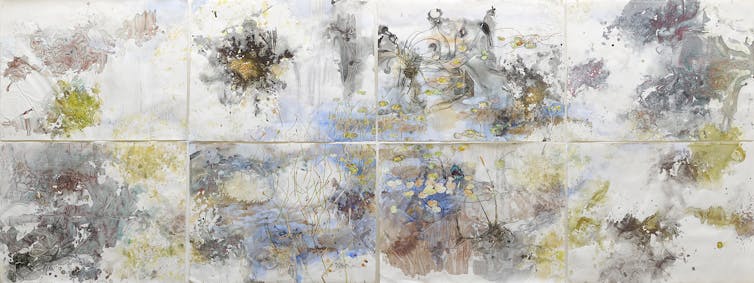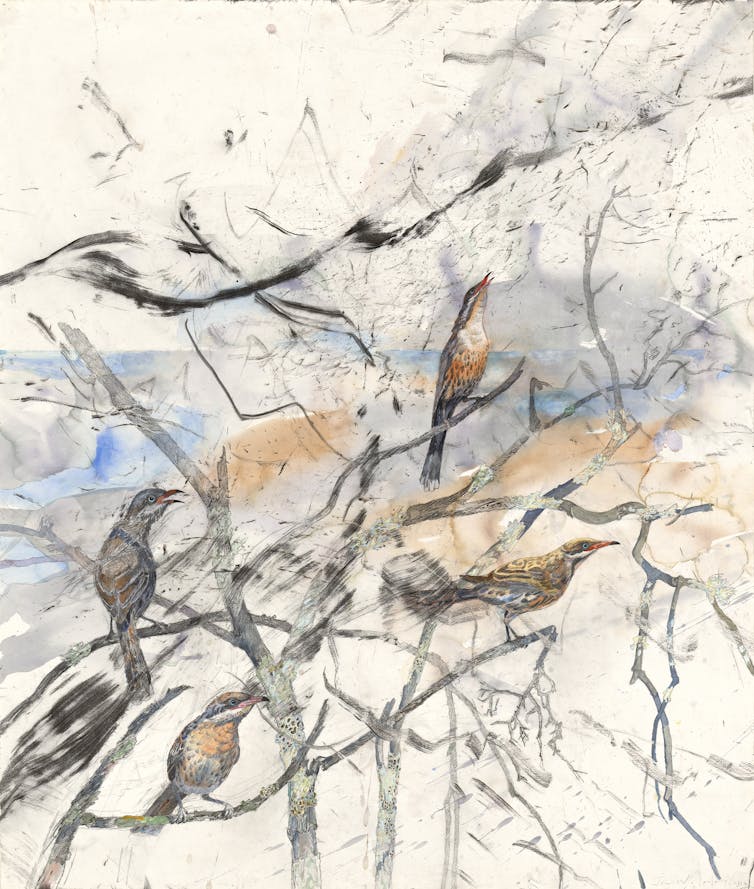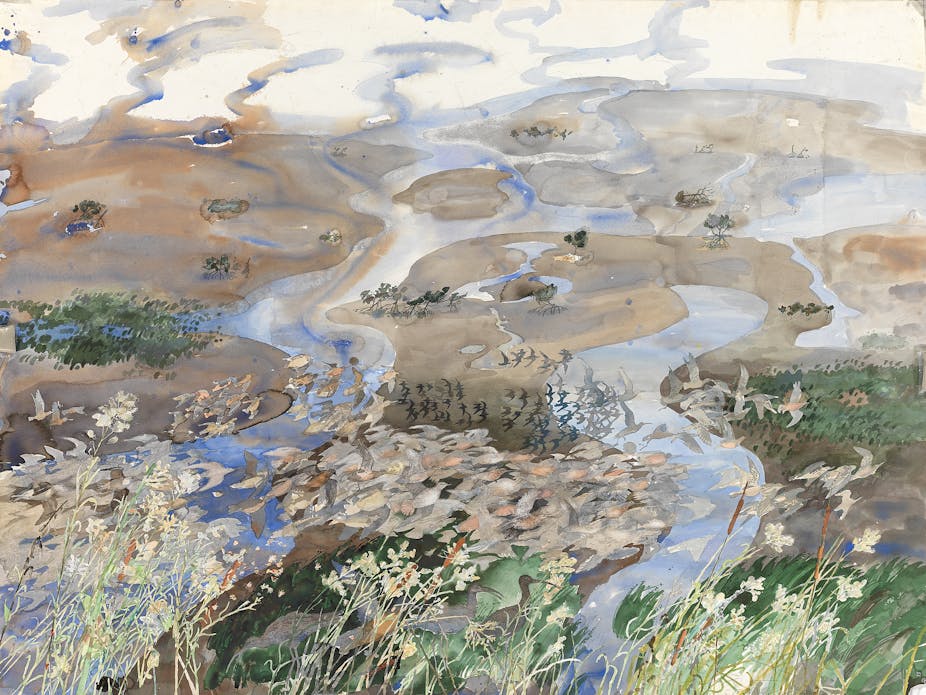John Wolseley’s exhibition Heartlands and Headwaters, which opened last month at the National Gallery of Victoria, may be the most important exhibition about art and the environment to be held in Australia for a generation.
Almost 40 years ago, Wolseley came to Australia and discovered a landscape which had been largely “unseen” by the eyes of European artists. This was in contrast with Europe, particularly his native England, where almost every scene had been distilled through the conventions of European art. The Australian environment invited a new and bold approach.
At the same time, Wolseley, through the eyes of the newly-arrived, became increasingly aware that the environment and the whole ecosystem were in a precarious state and under constant threat.
There are two fundamentally discrete approaches to landscape art and the difference lies in the positioning of the artist in relation to their subject. Does the artist stand behind the easel to observe the landscape, which is then rendered in the chosen medium, or is the artist an integral part of the landscape itself, viewing it from the inside?
Wolseley, even from his earliest work in Australia, has always adopted the latter course.

It is an approach which may be termed as an “anti-humanist” attitude to art. The term needs explaining.
Put simply, a humanist approach to art has at its core the idea that “man is the centre of all things”, in other words, the world exists to accommodate the human species and to provide for its wants, needs and desires. An “anti-humanist” approach denies the centrality of man, with man existing as part of the environment, but not the central or exclusive part, but one of many parts which have to interact and co-exist with the others.
Philosophically, an anti-humanist stance is neither new nor particularly difficult to comprehend, but its implementation as a strategy in art is a far more complex and challenging matter.
Over a number of decades, Wolseley has approached nature as an active collaborator, rather than something inanimate to be depicted by the artist. Wolseley exploits local pigments, pollens and charcoal, or uses as frottage the texture of stone surfaces, to empower nature to depict herself in her own terms.
Likewise he incorporates found fragments – pieces of bark, lichen, leaves, feathers, insects – into the fabric of the work. Close to his heart, I know, is the following comment by the novelist Italo Calvino:
Think what it would be to have a work conceived from outside self, a work that would let us escape the limited perspective of the individual ego, not only to enter into selves like our own but to give speech to that which has no language, to the bird perching on the edge of the gutter, to the tree in spring and the tree in fall, to stone, to cement, to plastic …
In giving voice to these elements in his art, Wolseley is empowering the natural environment at the expense of the artist.

Heartlands and Headwaters is Wolseley’s most ambitious project to date. Several decades ago, Sir Roderick Carnegie sponsored Fred Williams to paint the Pilbara, a project which was cut short by the artist’s untimely death.
This time, he sponsored Wolseley for four years to examine the aquatic lifeblood of the Australian continent. The body of work produced has been acquired by the patron and forms the spectacular exhibition at the National Gallery of Victoria.
The Heartlands and Headwaters series found a focal point in landscape sites spread throughout Australia, where Wolseley sought to unite the big dynamic forms of the land, like the movement of the mountains and sand dunes, with the minutiae of natural forms, including the details of the habitats of birds, insects and plants.
He also set out to incorporate in his paintings geological time, going back millennia, as well as more temporal concepts of time, such as the seasonal life cycle of a swamp lily. In many of these pieces Wolseley employs numerous systems of art making – frottage, direct impressions from animal and plant parts, inserted scientific diagrams, collage and décollage, leporello (folded papers), buried paintings and “ventifacts” – all employed to break the tyranny of the artist’s authority.
In the world of digital imaging and sound-bites, Wolseley to some extent reasserts what Immanuel Kant termed “Ding an sich” (the thing in itself), as an actual tactile presence. The whole performative process of his art making, with movement through the carbonised environment and the harnessing of the wind and rain involves a kinetic element, what one could describe as a form of action painting or a performative dimension, but one where the artist is a medium and facilitator, rather than the dictator in the process, and where voice is given to the different surroundings.

Landscape art through the ages has also been the carrier of an ideology and reflects the zeitgeist of the society, whether it be the landscapes of possession by John Glover or the escapist landscapes of weekend travellers escaping the filth and pollution of city life and finding refuge in a landscape at the end of a railway line as in the case of the so-called Heidelberg School painters.
The ideology and emotional tone of Wolseley’s landscapes reflects a very different zeitgeist: it is not about possession or an escape into nature, but more of a plea for survival and the urgent need to see the earth as a “sustainable system”.
No artist in Australia’s history has ever attempted something so vast and holistic, as this project conceived to map the lifeblood of Australia. While earlier artists, including Nolan and Drysdale, attempted to capture the heart of the Australian continent by showing the arid, dry interior or the red centre, Wolseley shows a vivid and pulsating image of Australia with life-giving waters pumping through its veins.
In this exhibition Wolseley emerges as a lyrical poet and a prophet who challenges some of the assumptions which we make about our future and our coexistence with our environment.
John Wolseley: Heartlands and Headwaters is at the National Gallery of Victoria until August 16. Details here.

